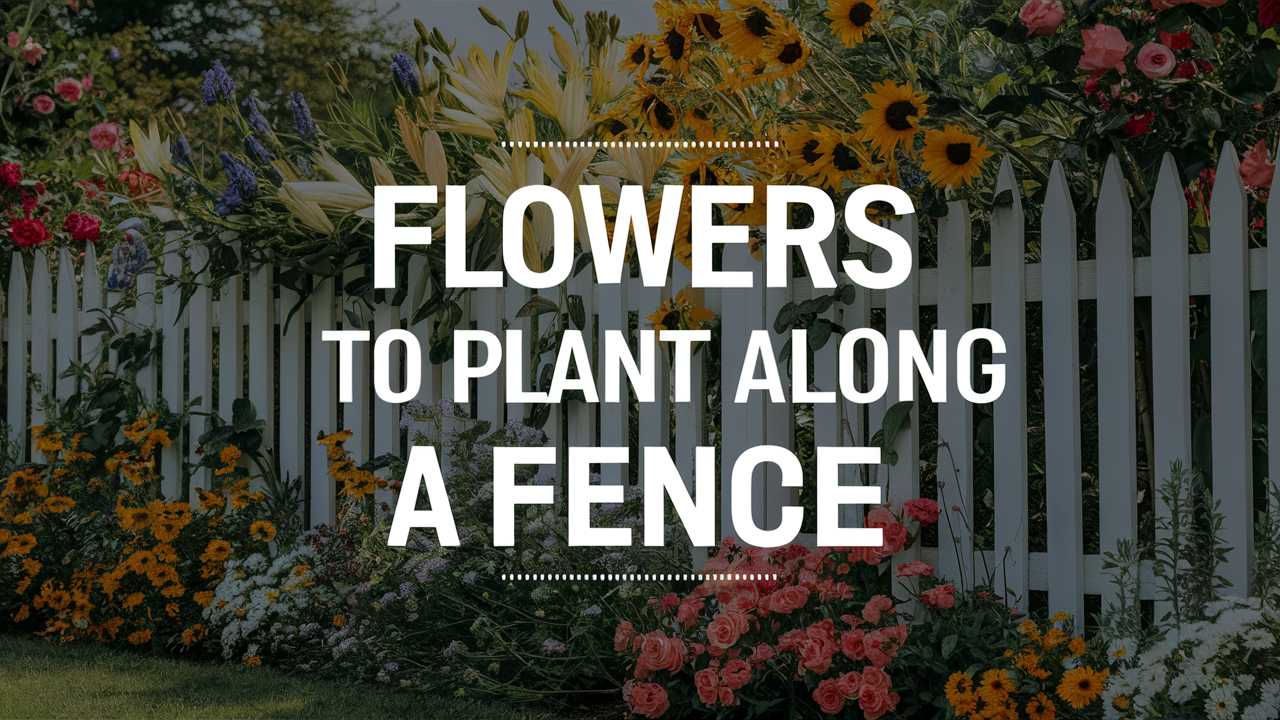Below, we’ll explore a selection of stunning flowers that thrive along fences, offering unique qualities that will enhance both your garden’s aesthetics and the local ecosystem. Let’s explore these remarkable plants!
Clematis
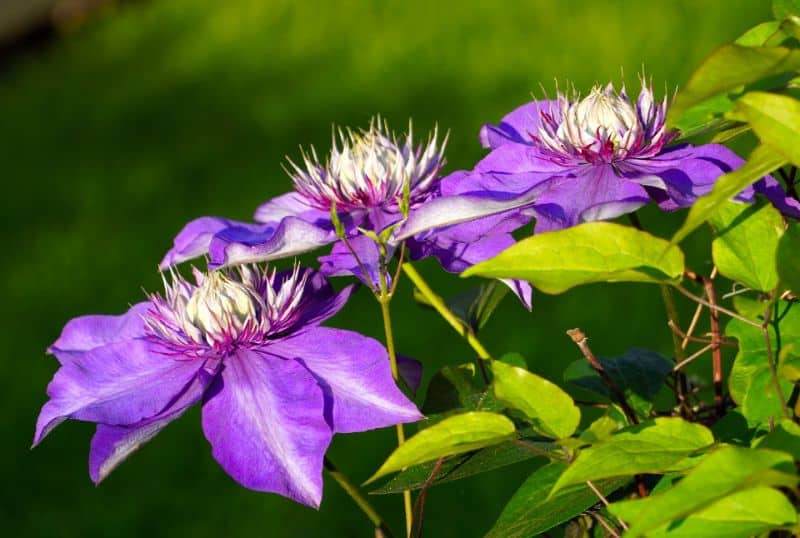
Clematis is a beloved climbing plant celebrated for its breathtaking blooms and versatility. This perennial vine comes in various species and cultivars, each presenting a spectrum of colors, shapes, and sizes. Growing clematis along your fence can create a dramatic vertical display, with flowers appearing in shades of purple, white, pink, and red.
One of the remarkable aspects of clematis is its late flowering varieties, which can add color to your garden even in late summer and early fall when many other plants have faded. Planting clematis is easy; just ensure you provide it with a sturdy support structure and full sun. It’s essential to note that different varieties have specific growth requirements regarding light and soil type, so consider this when selecting the ideal clematis for your space.
Clematis also holds an ecological benefit, attracting butterflies and pollinators, making your garden a haven for wildlife. This unique ability, coupled with its stunning flowering capabilities, makes it a wonderful addition to any fence.
Wisteria
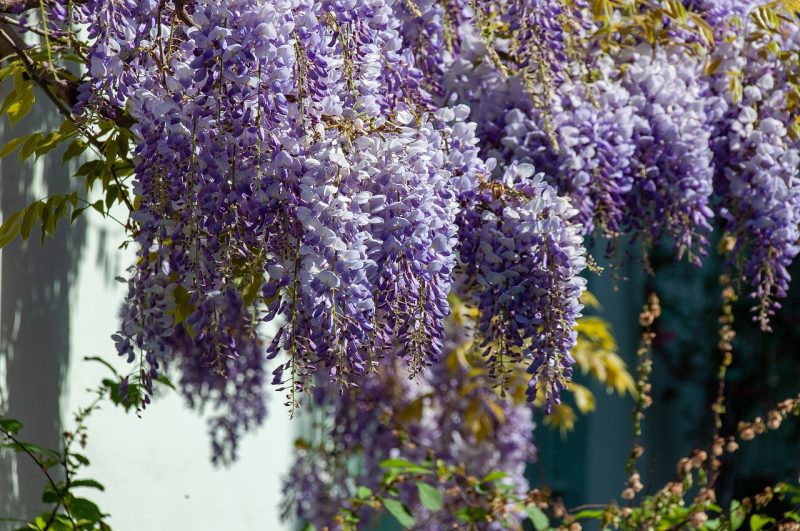
When thinking of enchanting long vines adorned with cascading flowers, wisteria immediately comes to mind. This vigorous climber produces clusters of drooping blooms that fragrance the air, creating a magical atmosphere. Wisteria is available in different shades, including violet, blue, white, and even pink.
While wisteria can be a stunning addition, it’s also essential to be mindful of its growth habit. It requires a robust support system due to its heavy and vigorous growth. Proper pruning is necessary to maintain its shape and prevent it from overtaking nearby structures or plants.
Wisteria thrives in full sun, which encourages abundant flowering. Not only does it add a romantic touch to any garden, but it also provides a habitat for various species of birds and insects. However, gardeners must keep in mind that wisteria contains a toxic component if ingested, so it’s wise to plant it away from play areas or where children might be curious.
Jasmine
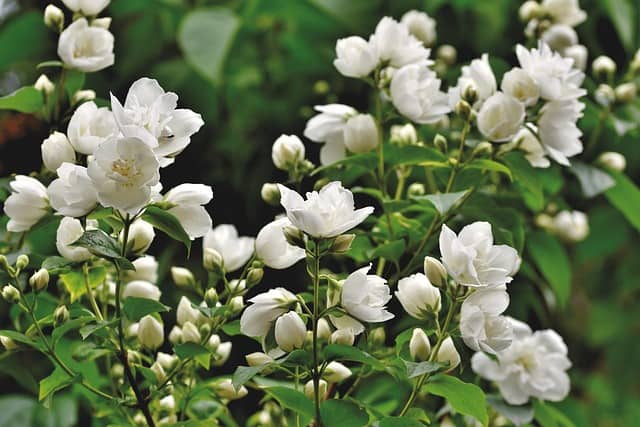
Jasmine is renowned for its intoxicating fragrance, making it a perfect choice for planting along fences where you can enjoy its aroma up close. There are multiple species of jasmine, but those that climb—like the common jasmine (Jasminum officinale) and star jasmine (Trachelospermum jasminoides)—are particularly popular for vertical gardens.
These lovely vines are often evergreen, ensuring that your fence remains cloaked in green even in the off-season. Jasmine prefers well-drained soil and full to partial sunlight. It is relatively low maintenance, requiring minimal pruning. The way their scent intensifies in the evenings adds an extra layer of romance to gardens, creating an oasis that’s ideal for nighttime enjoyment.
Jasmine is also a valuable attractor for pollinators, such as bees and butterflies, enhancing the ecological balance in your garden. The soft white and yellow blooms create a visually appealing backdrop against any fence, and their fragrant presence can transform an ordinary space into a delightful retreat.
Honeysuckle
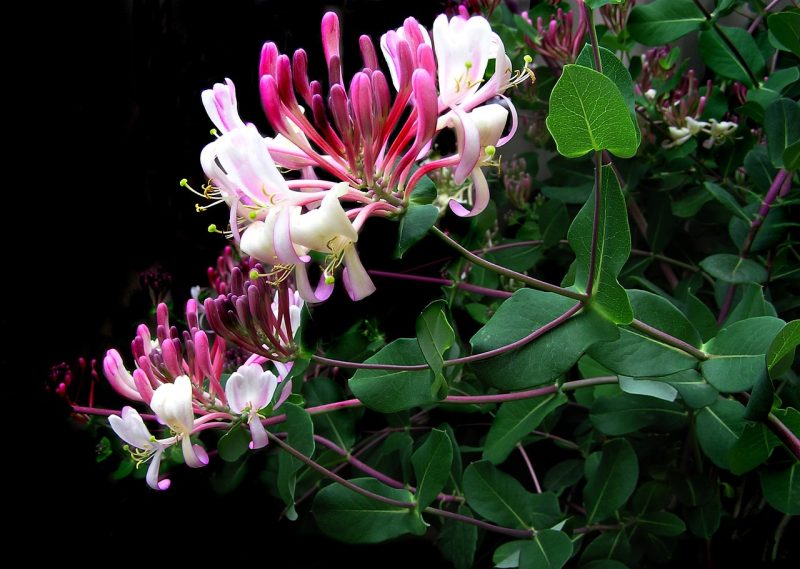
Honeysuckle is a classic choice for garden fences, known for its sweet-smelling flowers and ability to attract hummingbirds and butterflies. With a variety of species to choose from, including Lonicera japonica, honeysuckle comes in a palette of colors ranging from pale yellow to deep red.
This hardy vine is adaptable, thriving in various soil types, but it does best in well-drained environments with consistent moisture. Honeysuckle is also surprisingly fast-growing, which means you can expect a beautiful display relatively quickly. Regular pruning can help control its growth and encourage more blooms, making it a great hedge for reducing noise or providing privacy.
Fun fact: the flowers of some honeysuckle varieties are edible, and their nectar can be sipped directly from the blossoms. This sweet treat is just one of the many reasons to plant honeysuckle alongside your fence.
Bougainvillea
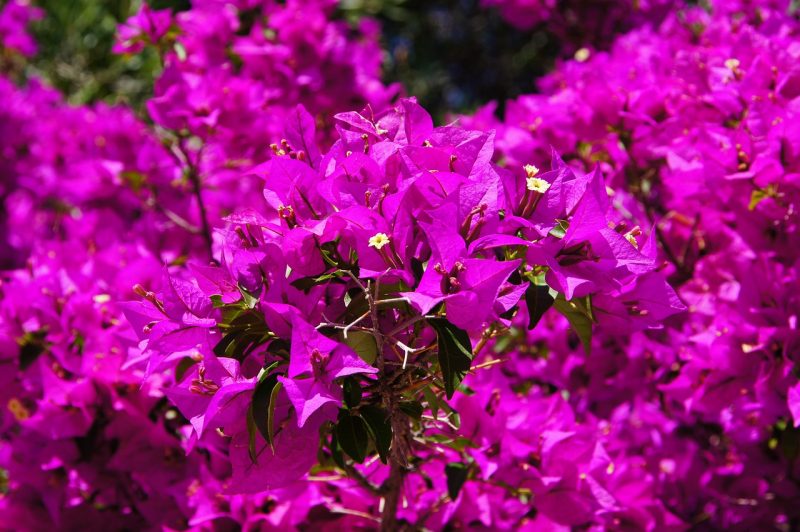
If you’re looking for a bold, vibrant splash of color, bougainvillea is a dazzling choice. Known for its brilliant bracts, which are often mistaken for flowers, bougainvillea thrives in warmer climates and prefers sunny locations. From flamingo pink to vibrant orange and purple, these hardy plants can dramatically enhance any fence, creating a tropical vibe.
Bougainvillea requires relatively low maintenance, needing only a well-drained soil and regular watering—though be cautious not to overwater. Once established, these plants can tolerate drought, making them a practical choice for those seeking heat-loving flora.
The sprawling vines can be trained along fences or trellises, creating exciting patterns and textures. Additionally, bougainvillea is excellent for attracting pollinators, including bees and butterflies, making it a favorite among gardeners. Just be aware of the thorns along the stems when positioning it near pathways!
Morning Glory
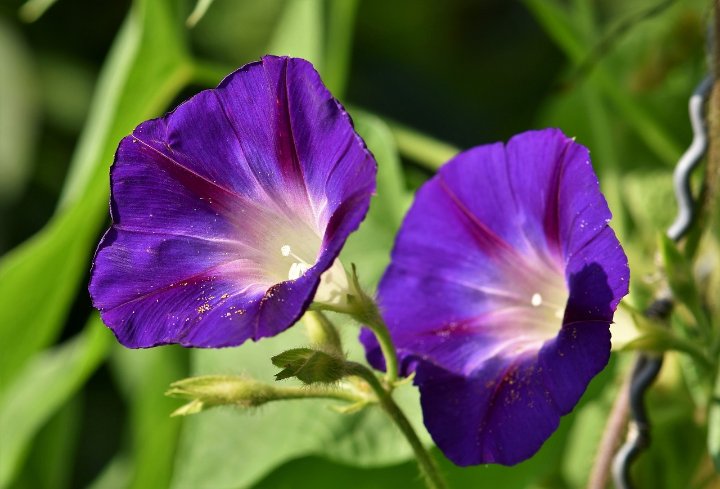
Morning glory is a vibrant, fast-growing annual that thrives on sunny fences. It’s beloved for its funnel-shaped flowers that bloom each morning, presenting a kaleidoscope of colors including purples, blues, and pinks. The ephemeral nature of its blooms is part of its charm, creating a delightful surprise each day.
These plants perform best in full sun and well-drained soil, requiring moderate watering. They are known to climb effectively on trellises and fences, providing charming green coverage in a short period. Morning glories can readily self-seed, meaning if you enjoy them one year, they’ll likely return the next—though be mindful of their tendency to spread.
While beautiful, it’s essential to note that some species of morning glory can be invasive in certain regions, so checking local guidelines is a good idea before planting them. When positioned correctly, these colorful bloomers can create a captivating backdrop for your garden.
Trumpet Vine
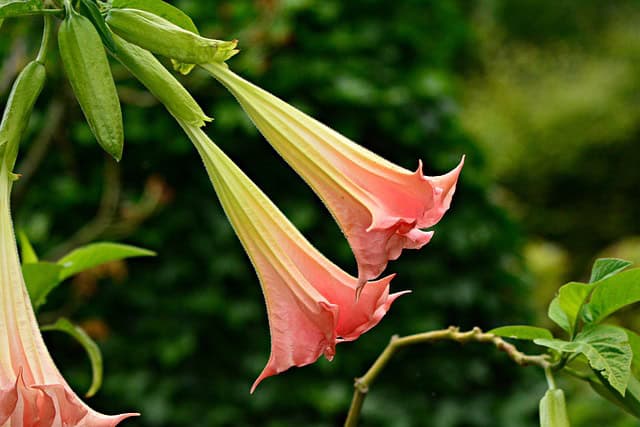
Characterized by its striking, trumpet-shaped flowers, trumpet vine (Campsis radicans) is a must-have for gardeners looking to attract hummingbirds to their yard. The bright orange and red flowers bloom throughout summer, providing a spectacular show of color that commands attention.
Trumpet vines are vigorous growers, often requiring strong support to manage their rapid growth. They thrive in full sun and can tolerate poor soil, making them a versatile choice. Just be cautious—this vine can become invasive in certain regions, so proper control and maintenance are necessary to prevent it from taking over.
The dense foliage of the trumpet vine also provides a natural habitat for various bird species, making your garden not only visually appealing but also ecologically friendly. Consider pairing trumpet vine with more subdued flowering plants to create a perfect balance in color and texture.
Climbing Hydrangea
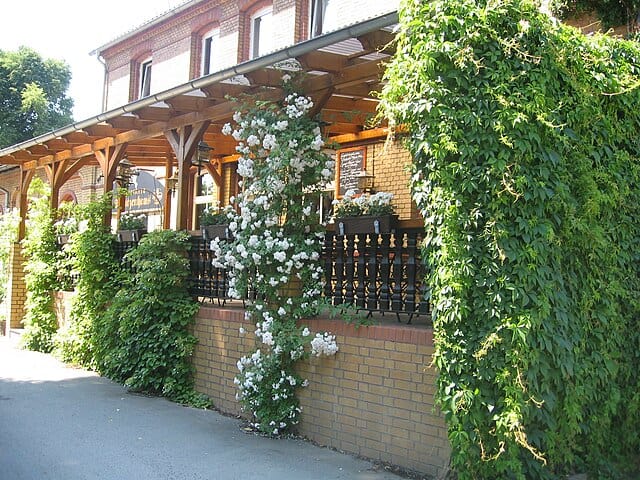
For those who prefer softer colors and a more subdued touch, climbing hydrangea (Hydrangea anomala petiolaris) is a stunning option. This perennial vine can blanket your fence in lush green foliage, featuring clusters of creamy white flowers that provide a gentle contrast against a dark wooden fence or brick backdrop.
Climbing hydrangeas thrive in partial to full shade, making them ideal for areas that receive less direct sunlight. They can take a few years to establish but reward your patience with their lovely blooms and impressive growth. Once settled, climbing hydrangeas can cover large areas, providing an exquisite wall of greenery.
Another advantage is their adaptability to various soil types, though they favor moist, well-drained conditions. Additionally, climbing hydrangeas are known for their ability to support local biodiversity, providing nesting sites for birds and attracting beneficial insects.
Passionflower
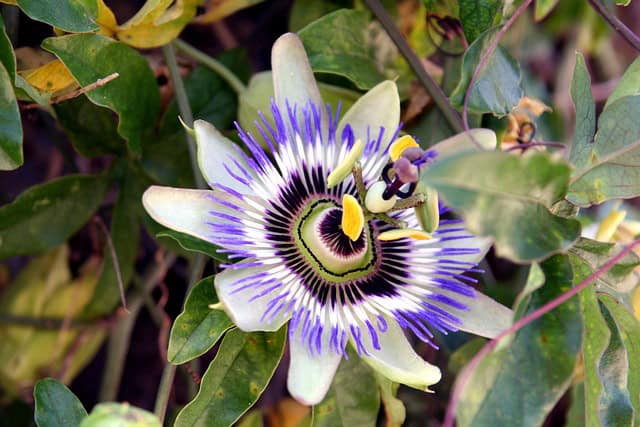
Passionflower is a unique and exotic climbing plant, famed not just for its unusual appearance but also for the delightful passion fruit it produces. The intricate blooms, often in shades of purple and white, can transport you to a tropical paradise right in your backyard.
These hardy vines can thrive in various climates, including hot and humid regions, as well as cooler areas as long as they receive adequate sunlight. Passionflower generally prefers well-drained soil and regular watering, allowing them to flourish along fences, trellises, or arbors.
Aside from their stunning flowers, passionflowers also attract pollinators like butterflies and bees, making them a great addition to any pollinator-friendly garden. Plus, if you choose to grow the edible variety, you’ll have delicious passion fruit to enjoy as a tasty reward for your gardening efforts.
Black-eyed Susan Vine
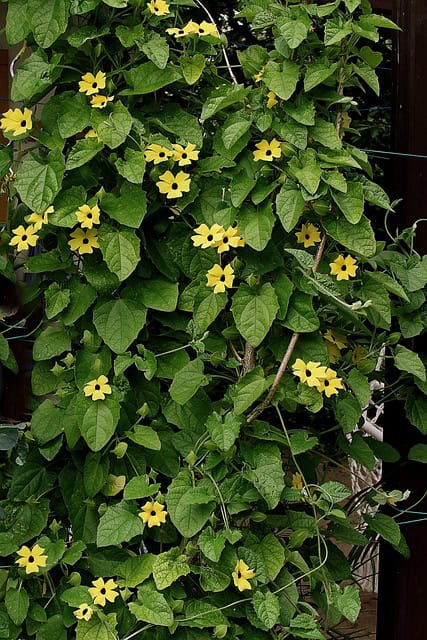
The black-eyed Susan vine (Thunbergia alata) offers a delightful pop of color that can instantly brighten up any fence space. With its striking yellow, orange, or even white petals and distinct dark center, this vine is sure to attract attention.
This fast-growing annual climber thrives in full sun, ensuring maximum blooms throughout the summer months. Black-eyed Susan vine is relatively easy to maintain, requiring moderate watering and well-drained soil. It can rapidly ascend fences, trellises, and arbors, creating an eye-catching display.
One of the great attributes of this vine is its ability to attract both pollinators and beneficial insects. The flowers can also bring a delightful charm to any garden scene, effectively softening the look of a stark fence or wall.
Sweet Pea
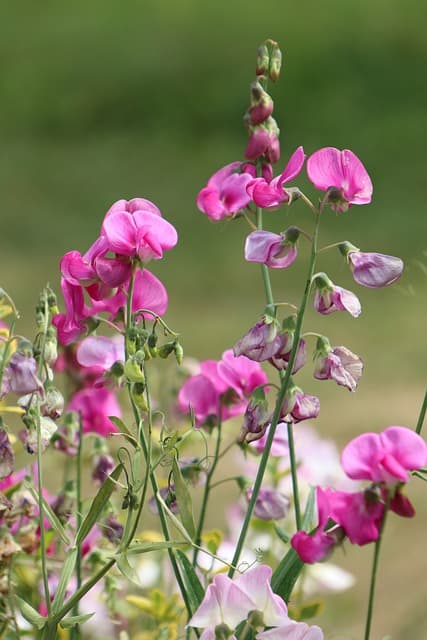
For an old-fashioned charm, sweet peas (Lathyrus odoratus) are perfect for adorning fences. Their delightful scent and vibrant colors, ranging from soft pastels to bold hues, make them a favorite among gardeners.
Sweet peas are annuals that thrive in well-drained soil and seek full sun to partial shade. They are typically grown from seed, resulting in lush, climbing vines that can reach impressive heights on trellises or fences. A key feature of sweet peas is their fragrant flowers, which are incredible not just in the garden but also when cut for bouquets indoors.
Sweet peas benefit from regular deadheading, which can encourage continuous blooms throughout the growing season. With the right care, you’ll create a fragrant, stunning garden feature that exudes a charming atmosphere.
Climbing Rose
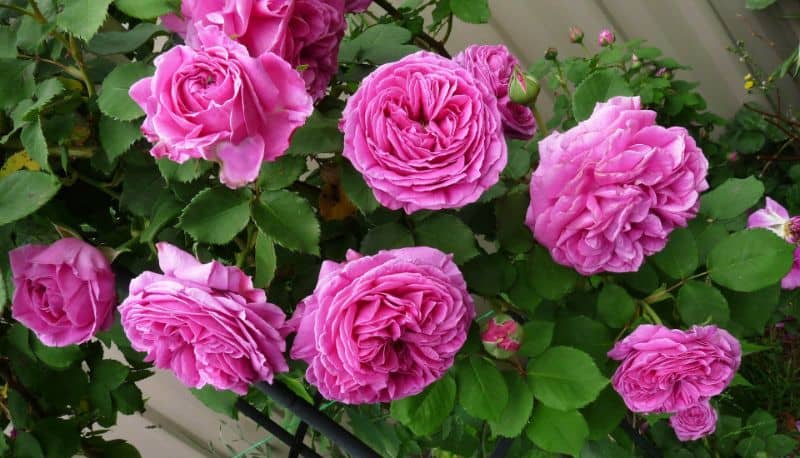
For an exquisite, classic look, climbing roses (Rosa) offer breathtaking beauty and versatility. These perennial favorites combine the allure of roses with the ability to elegantly scale fences, providing a romantic ambiance to your garden.
Climbing roses come in various colors and types, from delicately frilled petals to bold, robust blooms. They prefer sunny locations along with well-drained soil, and it’s crucial to provide them with ample support as they grow. Pruning is essential for maintaining their size and shape, allowing them to thrive as stunning focal points rather than becoming unruly.
Once flowering, climbing roses can create a visual spectacle that draws admiration and can serve as a backdrop for special garden gatherings. Their fragrant blooms not only captivate the eye but are a significant attractor for pollinators, enriching your garden’s biodiversity.
Star Jasmine
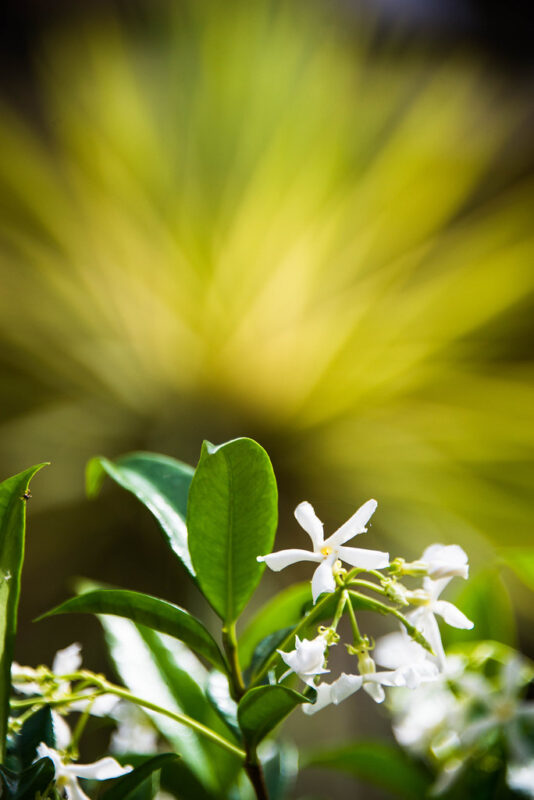
Star jasmine (Trachelospermum jasminoides) is ideal for gardeners seeking a climbing plant with lovely fragrance and glossy green foliage. This semi-evergreen vine produces small, star-shaped white flowers that emit an incredible fragrance, often likened to a classic gardenia smell.
Star jasmine flourishes in well-drained soil and prefers full to partial sunlight. It’s relatively low-maintenance, requiring pruning mainly to keep it in shape. Due to its dense growth habit, it can also serve as a privacy screen along your fence.
The evergreen quality of star jasmine ensures year-round greenery, bringing texture and life to your outdoor space. Planting star jasmine along your fence creates not just a visual barrier against neighboring properties, but an aromatic oasis inviting relaxation and comfort.
Fuchsia
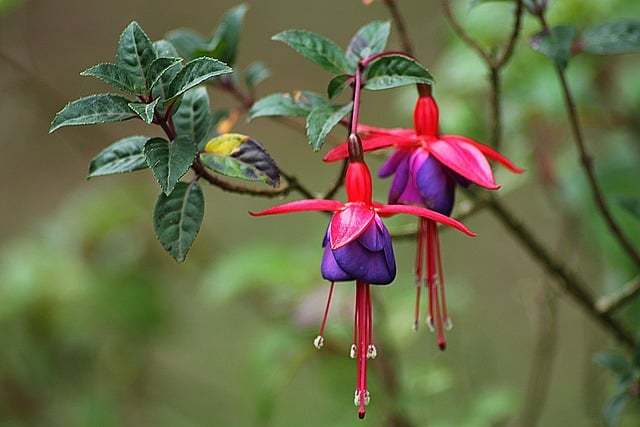
Fuchsia offers a whimsical flare to any fence with its drooping, tubular flowers that dangle like delicate lanterns. Known for its vibrant morphology, you’ll find fuchsia in various colors, from fuchsia pink to electric purple.
These charming plants prefer partial shade and should be protected from harsh afternoon sun, which can scorch their sensitive leaves. Fuchsia does best in well-drained soil rich in organic matter and enjoys consistent moisture to thrive.
With their unique, eye-catching blooms and graceful appearance, fuchsias can serve as both climbing plants and hanging basket masterpieces, attracting hummingbirds and other pollinators. When carefully placed, fuchsia can add an enchanting element to any garden fence, showcasing nature’s artistry in full bloom.
Nasturtium
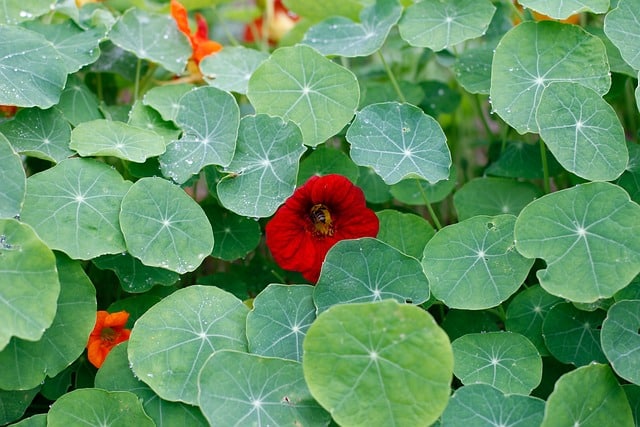
Nasturtium (Tropaeolum majus) is not only a visual delight but also an edible treasure for gardeners. With its vibrant flowers in various shades of red, orange, and yellow, nasturtium can brighten up a fence while also offering beautiful garnishes for your meals.
This low-maintenance annual thrives in full sun and poor soil, showcasing its adaptability. The foliage can create a striking display, capturing the eye and inviting curiosity. Nasturtium flowers and leaves are edible, adding peppery flavors to salads and other dishes.
Moreover, they attract pollinators and can be beneficial in preventing pests harmful to neighboring plants. Growing nasturtiums along your fence can seamlessly blend beauty with practicality.
Azaleas
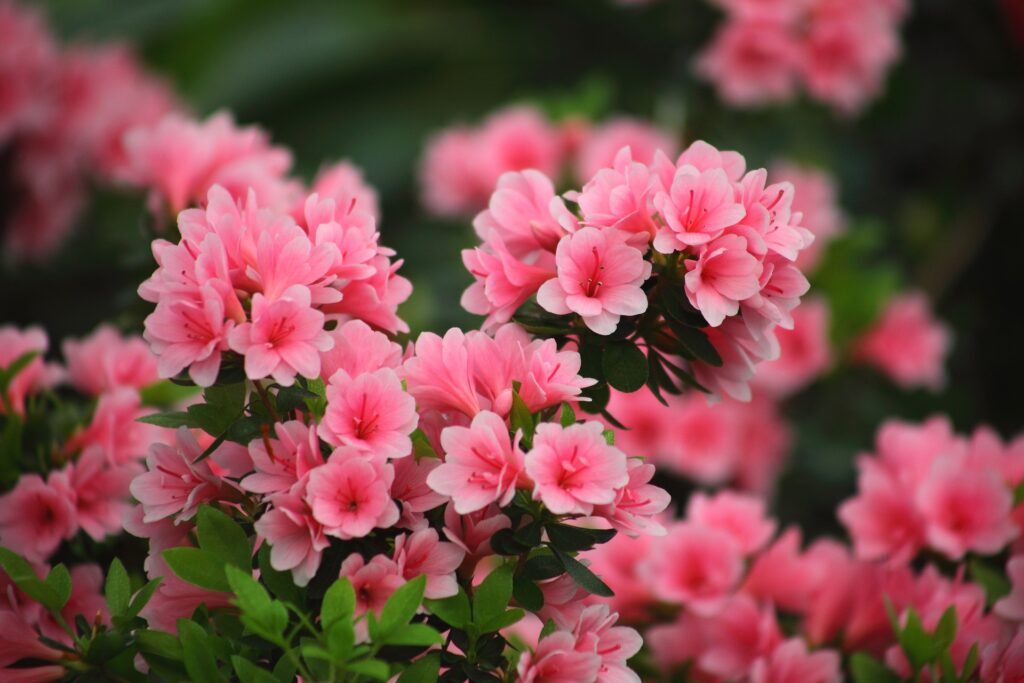
Though typically grown as shrubs, certain azalea varieties can effectively function alongside fences to provide rich, colorful displays during blooming season. Known for their showy flowers, azaleas bloom in shades of white, pink, red, and purple, often bringing a cheerful presence to any fence area.
These flowering shrubs thrive in acidic, well-drained soil and prefer partial shade, making them ideal for shaded areas near fences. Care should be taken to ensure they receive appropriate hydration, especially in drier climates.
Azaleas create a striking barrier, especially when planted in groups, forming a vivid, colorful hedge. They can also attract butterflies, enriching the biodiversity of your space while simultaneously offering a gorgeously vibrant viewing area.
Forsythia
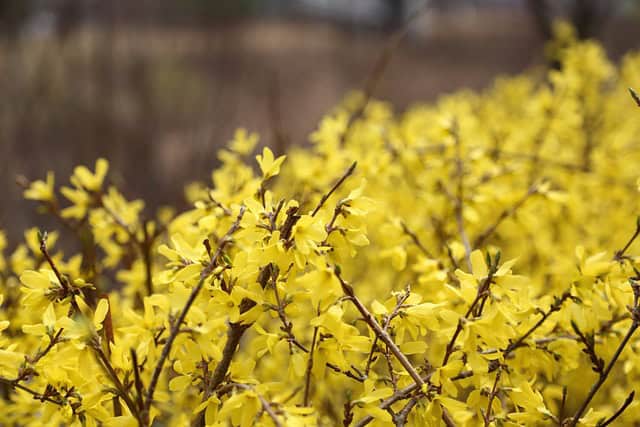
Forsythia is a herald of spring, with its brilliant yellow flowers that burst into bloom before the leaves appear. Ideal for fence planting, forsythia can create a stunning backdrop of vibrant color as your fence comes alive in the early season.
This shrub prefers full sun to partial shade, thriving in various soil types as long as they are well-drained. Forsythia is a fast-growing plant that can quickly create a dense hedge, offering both beauty and privacy.
Cutting back can help rejuvenate plants and encourage new growth for future years. With their bright golden blooms and easy growth habits, forsythias are an excellent choice for adding cheerful contrast along your fence as winter wanes.
Butterfly Bush
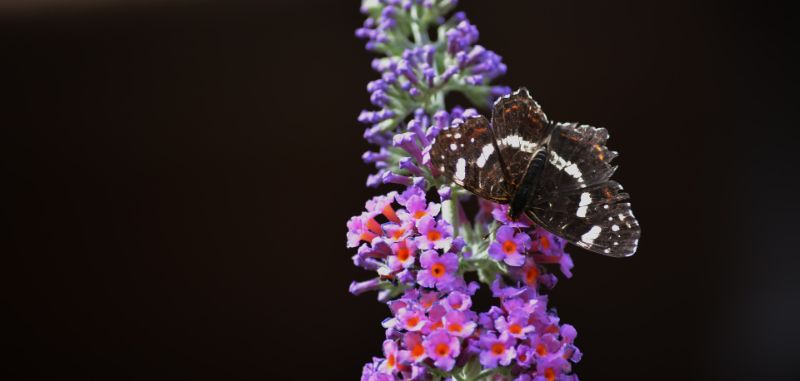
A real magnet for butterflies, the butterfly bush (Buddleja) is a stunning addition to garden fences. With its elongated flowering spikes in colors ranging from violet to white, the profiles of butterfly bush create delightful visual and sensory interest.
This shrub prefers full sun and well-drained soil, becoming a showstopper when in full bloom. Regular deadheading will encourage prolonged blooming throughout summer, making it an excellent choice for attracting various butterflies and pollinators to your garden.
While butterfly bushes can be easily cultivated, keep in mind that they can be invasive in certain areas; thus, check local guidelines. With a perfect mix of beauty and utility, butterfly bushes provide ample nectar to local wildlife while bringing vibrant life to your fence.
Camellia
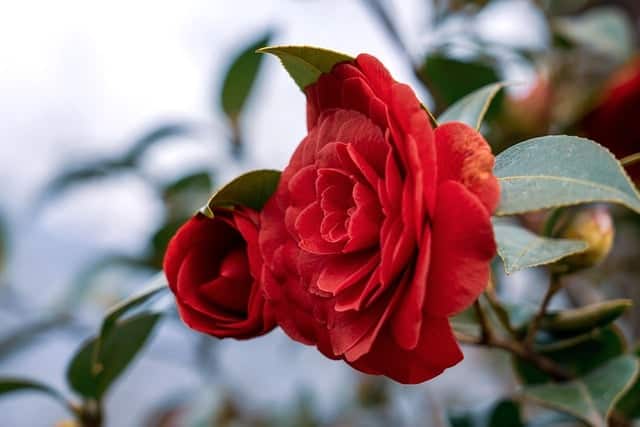
Camellias are a classic choice for adding elegance and beauty to your garden area. Available in various colors, including white, pink, and red, they bloom in the cooler months, creating a striking contrast to the usual spring and summer flowers.
These evergreen shrubs develop alongside fences perfectly, providing an all-year-round lush green backdrop that blooms brilliantly in winter. While they prefer partial shade and acidity in the soil, camellias can adapt to various conditions, thriving with moderate care.
Though camellias may seem regal, they can be relatively easy to cultivate. They attract various beneficial insects, supporting a diverse ecosystem. Additionally, their lush foliage softens the look of garden fences while instilling sophistication throughout the outdoor space.
Viburnum
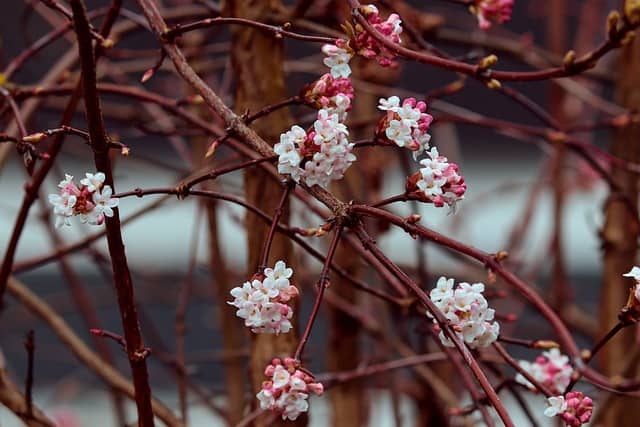
Viburnum is a diverse genus that encompasses many species suited for various landscaping applications, including along fences. Known for its clusters of fragrant flowers and striking berries, viburnum creates visual interest throughout multiple seasons.
These hardy shrubs thrive in well-drained soil and can handle full sun to part shade, making them versatile companions for your garden. While some viburnum varieties may bear more fruit than others, all maintain robust growth patterns that lend themselves beautifully to privacy screening.
Many species of viburnum attract pollinators and offer habitat for birds seeking cover while nurturing wildlife. Energetic blooming flowers in spring followed by colorful berries in fall make viburnum a delightful plant to enhance any fence area.


